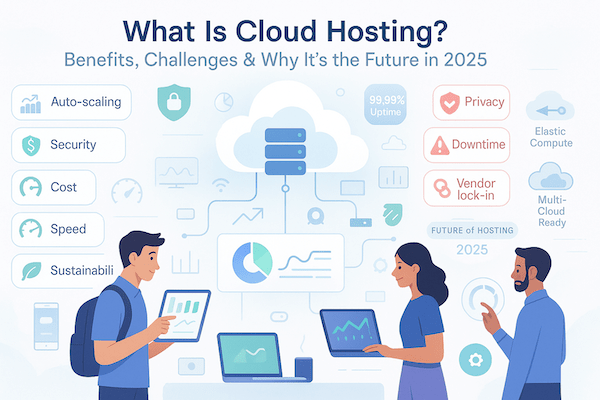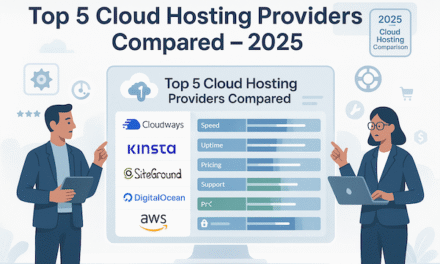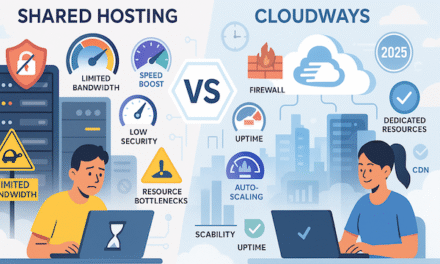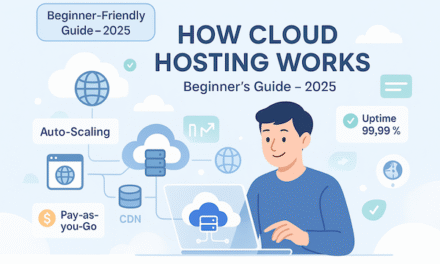some The digital transformation accelerating across industries has made cloud hosting more than just a technology trend—it’s become the backbone of modern business operations. As we navigate through 2025, organizations worldwide are investing heavily in cloud infrastructure, with global spending projected to reach nearly $600 billion. But what exactly is cloud hosting, and why is it considered the future of web infrastructure?
This comprehensive guide explores everything you need to know about cloud hosting in 2025, from its fundamental concepts and compelling benefits to the challenges organizations face and the emerging trends shaping its future. Whether you’re a business owner evaluating hosting options or an IT professional planning your infrastructure strategy, this article provides the insights you need to make informed decisions.
What Is Cloud Hosting? A Complete Definition
Cloud hosting is a revolutionary approach to web hosting that leverages a network of virtual servers spread across multiple data centers to host websites, applications, and services. Unlike traditional hosting methods that rely on a single physical server, cloud hosting creates a virtual environment where computing resources—including processing power, storage, and memory—are pooled from multiple servers and made available on-demand.
The fundamental principle behind cloud hosting lies in virtualization technology. This process creates virtual machines (VMs) on physical servers, allowing multiple isolated environments to coexist on the same hardware while sharing resources efficiently. When you choose cloud hosting, your website or application doesn’t depend on a single server but instead utilizes a distributed network of interconnected servers, ensuring better performance, reliability, and scalability.
How Cloud Hosting Works
Cloud hosting operates through a sophisticated infrastructure that involves several key components:
- Virtualization Layer: A hypervisor creates virtual machines on physical servers, dividing resources among multiple users while maintaining isolation.
- Load Distribution: Traffic and workloads are automatically distributed across multiple servers to optimize performance and prevent overload.
- Resource Pooling: Computing resources from various servers are combined into a shared pool, allowing for dynamic allocation based on demand.
- Auto-Scaling: The system automatically adjusts resources up or down based on real-time usage patterns and requirements.
- Redundancy: Multiple copies of data and applications are maintained across different servers and locations to ensure high availability.
Cloud Hosting vs Traditional Hosting: Key Differences
| Aspect | Traditional Hosting | Cloud Hosting |
|---|---|---|
| Infrastructure | Single physical server | Network of virtual servers |
| Scalability | Limited by server capacity | Virtually unlimited scaling |
| Pricing Model | Fixed monthly/annual fees | Pay-as-you-use model |
| Reliability | Single point of failure | High availability with redundancy |
| Resource Allocation | Fixed resources | Dynamic resource allocation |
| Setup Time | Hours to days | Minutes to hours |
The Compelling Benefits of Cloud Hosting in 2025
Cloud hosting offers numerous advantages that make it the preferred choice for businesses of all sizes. Let’s explore the key benefits that are driving widespread adoption:
🚀 Unmatched Scalability
Cloud hosting provides elastic scalability that adapts to your business needs in real-time. Whether you’re experiencing a sudden traffic spike or seasonal fluctuations, resources can be automatically scaled up or down without downtime. This flexibility is particularly valuable for e-commerce sites during peak shopping seasons or content platforms experiencing viral growth.
💰 Cost Effectiveness
The pay-as-you-use model eliminates the need for large upfront investments in hardware. Businesses can significantly reduce operational costs by only paying for resources they actually consume. Studies show that migrating to cloud hosting can help businesses unlock additional revenue streams, potentially boosting profit growth by up to 11.2% year-over-year.
🛡️ Enhanced Reliability
With data distributed across multiple servers and locations, cloud hosting offers superior uptime compared to traditional hosting. If one server fails, traffic is automatically rerouted to healthy servers, ensuring continuous availability. Most cloud providers offer 99.9% or higher uptime guarantees.
⚡ Superior Performance
Cloud hosting leverages Content Delivery Networks (CDNs) and geographically distributed servers to deliver content faster to users worldwide. Advanced caching mechanisms and load balancing ensure optimal performance even during high-traffic periods.
🔒 Robust Security
Leading cloud providers invest heavily in security infrastructure, offering enterprise-grade protection including firewalls, DDoS protection, regular security updates, and compliance with industry standards like GDPR, HIPAA, and SOC 2.
🌍 Global Accessibility
Cloud hosting enables worldwide accessibility of your applications and data. With servers located in multiple regions, users can access your services from anywhere with optimal performance and reduced latency.
📊 Cloud Hosting Statistics for 2025
- 60% of corporate data is now stored in the cloud, double the amount from 2015
- More than 92% of organizations use cloud computing services
- The global cloud hosting market is expected to reach $1.266 trillion by 2028
- AWS leads the market with 33% market share, followed by Microsoft Azure at 23%
- Average individuals use around 36 cloud services daily
- 200 zettabytes of data are projected to be stored in the cloud by 2025
Cloud Hosting Challenges: What You Need to Know
While cloud hosting offers significant advantages, it’s important to understand the potential challenges and how to address them effectively:
🔐 Security and Privacy Concerns
Data security remains a primary concern for organizations moving to the cloud. Storing sensitive information on third-party servers raises questions about data protection, privacy compliance, and unauthorized access. In 2025, sophisticated threats like AI-driven phishing attacks and Ransomware-as-a-Service (RaaS) are becoming more prevalent.
Solutions:
- Implement end-to-end encryption for data in transit and at rest
- Use multi-factor authentication and access controls
- Choose providers with strong security certifications and compliance standards
- Regular security audits and penetration testing
- Implement Zero Trust security architecture
💸 Cost Management Complexity
Unpredictable costs can be a significant challenge with cloud hosting. The pay-as-you-go model, while cost-effective, can lead to unexpected expenses if not properly monitored. Studies show that cloud waste averages 30-32% of companies’ cloud budgets.
Solutions:
- Implement cost monitoring and analytics tools
- Use automated scaling to match resource allocation with actual demand
- Regular resource audits and rightsizing
- Adopt FinOps practices for better cost governance
- Consider reserved instances for predictable workloads
🔗 Vendor Lock-in Risks
Vendor dependency can make it difficult and expensive to switch providers due to proprietary technologies and data migration complexities. This can limit flexibility and negotiating power.
Solutions:
- Adopt multi-cloud strategies to reduce dependency
- Use containerization and microservices for better portability
- Implement open standards and APIs
- Plan exit strategies before committing to a provider
Why Cloud Hosting Is the Future: 2025 Trends and Beyond
Several emerging trends are positioning cloud hosting as the dominant infrastructure model for the future:
🤖 AI and Machine Learning Integration
Artificial Intelligence is becoming deeply integrated into cloud hosting platforms, enabling intelligent automation, predictive scaling, and enhanced security. AI-powered tools help optimize resource allocation, detect anomalies, and automate routine management tasks. By 2025, we expect to see more AI-driven features that make cloud hosting more efficient and self-managing.
🌱 Sustainability and Green Computing
Environmental responsibility is driving cloud providers to adopt renewable energy sources and improve energy efficiency. Major providers like AWS, Microsoft Azure, and Google Cloud are committing to carbon neutrality by 2030. Data centers powered by renewable energy and advanced cooling technologies are becoming the standard.
📱 Edge Computing Expansion
Edge computing brings processing closer to data sources, reducing latency and improving performance for IoT applications and real-time services. IDC predicts that spending on edge computing will reach $274 billion by 2025, driven by 5G adoption and IoT growth.
Choosing the Right Cloud Hosting Solution
Selecting the optimal cloud hosting provider requires careful consideration of several factors:
Key Evaluation Criteria
- Performance and Reliability: Look for providers offering 99.9%+ uptime guarantees, global CDN networks, and fast response times.
- Scalability Options: Ensure the platform can handle your growth projections with automatic scaling capabilities.
- Security Features: Evaluate encryption, access controls, compliance certifications, and security monitoring tools.
- Pricing Transparency: Choose providers with clear pricing models and cost management tools.
- Support Quality: 24/7 technical support with expertise in your technology stack.
- Integration Capabilities: Compatibility with your existing tools and third-party services.
Popular Cloud Hosting Providers in 2025
- Amazon Web Services (AWS): Market leader with comprehensive services and global infrastructure
- Microsoft Azure: Strong enterprise integration and hybrid cloud capabilities
- Google Cloud Platform: Excellent for data analytics and machine learning workloads
- IBM Cloud: Focus on hybrid cloud and enterprise solutions
- DigitalOcean: Developer-friendly with simple pricing and good performance
- Vultr: Cost-effective solutions with global presence
Implementation Best Practices
Successfully migrating to cloud hosting requires strategic planning and execution:
Migration Strategy
- Assessment Phase: Evaluate current infrastructure, applications, and requirements
- Planning Phase: Develop migration timeline, resource allocation, and risk mitigation strategies
- Pilot Testing: Start with non-critical applications to test the platform and processes
- Gradual Migration: Move applications in phases to minimize disruption
- Optimization: Continuously monitor and optimize performance, costs, and security
Cost Optimization Strategies
- Right-sizing: Regularly adjust resource allocation to match actual usage
- Reserved Instances: Commit to long-term usage for significant cost savings
- Auto-scaling: Implement automatic scaling to prevent over-provisioning
- Cost Monitoring: Use cloud cost management tools for visibility and control
- Resource Tagging: Organize resources for better tracking and accountability
The Future Outlook: What to Expect Beyond 2025
Looking ahead, several developments will continue to shape the cloud hosting landscape:
- Quantum Computing Integration: Early adoption of quantum-safe cryptography and quantum computing services
- Serverless Computing Growth: Increased adoption of Function-as-a-Service (FaaS) models
- 5G and Edge Convergence: Better integration between 5G networks and edge computing
- Autonomous Cloud Management: AI-driven platforms that self-manage and optimize
- Sustainability Focus: Carbon-neutral and carbon-negative cloud services becoming standard
Ready to Embrace the Future of Hosting?
Cloud hosting isn’t just a trend—it’s the foundation of modern digital infrastructure. As we progress through 2025 and beyond, organizations that embrace cloud hosting will benefit from increased agility, cost efficiency, and competitive advantage.
Start your cloud journey today and position your business for success in the digital-first future.
Final thoughts
Cloud hosting has evolved from an innovative concept to an essential business infrastructure in 2025. Its benefits—including unmatched scalability, cost-effectiveness, reliability, and security—far outweigh the challenges when properly implemented. As emerging technologies like AI, edge computing, and sustainable practices continue to enhance cloud capabilities, the future of hosting is undoubtedly in the cloud.
Organizations that understand and leverage cloud hosting effectively will be better positioned to adapt to changing market conditions, scale efficiently, and deliver superior user experiences. The question isn’t whether to adopt cloud hosting, but how quickly you can transition to take advantage of its transformative potential.
By staying informed about the latest trends, addressing potential challenges proactively, and following best practices for implementation, businesses can harness the full power of cloud hosting to drive growth and innovation in the years ahead.
🚀 Ready to explore cloud hosting the easy way? Try Cloudways for Free and get blazing-fast performance in minutes.





